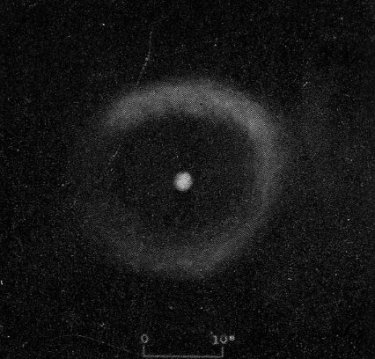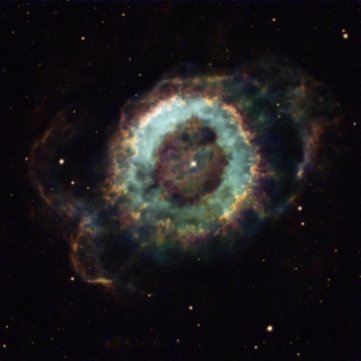NGC 6369
THE LITTLE GHOST NEBULA
"A regular, nearly round ring...quite faint" says Curtis, as seen
in the left hand composite drawing. NGC 6369's faintness is no
surprise, as the planetary nebula,
in far southeastern Ophiuchus (two
degrees northeast of Theta Oph) is only
7 degrees west of the center of the Galaxy (and of the Summer
Solstice in Sagittarius), and is thus very
much dimmed by intervening interstellar dust. Were it not there,
the nebula and its 16th magnitude (15.6) star would be some
30 or more times brighter!
The distance, as usual, is uncertain. The best estimate seems to
be about 2000 light years, but it could be twice as far. With a
rather large angular diameter of 28 seconds of arc (which
contributes to low surface brightness), at that distance the nebula
would be 0.3 light years across.
With no (or at best marginal) twice-ionized helium, the central
star must be relatively cool, the measured value 58,000 Kelvin.
Its luminosity is also relatively low, about 1000 times that of the
Sun (though if you double the distance, it becomes four times
brighter). Given these values, the star (the old nuclear-burning
core of a one-time advanced
giant) has a modest mass of a bit over half solar (consistent
with non-elevated abundances). If so, the progenitor star may have
been rather like the Sun. While still
heating a bit, the star will shortly turn around and begin to cool
as a nascent white dwarf,
as the nebula, expanding rather rapidly at 41 kilometers per
second, fades off into interstellar space.
Curtis's view is a mere shadow of the spectacular Hubble image on
the right (which for a match should be rotated 40 degree to the
right). The high resolution reveals knotty detail and a huge,
symmetric, curling outer halo about twice as big as the inner ring,
which was already known from ground-based images. While the
beautiful outer structure was too faint for Curtis to see, he did
capture the inner's ring's variations in brightness.
Left: Quote and image by H. D. Curtis from Publications of the Lick
Observatory, Volume 13, Part III, 1918. Right: NASA and the Hubble
Heritage Team (STScI/AURA).



